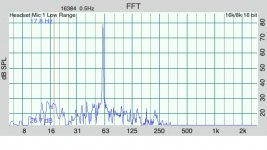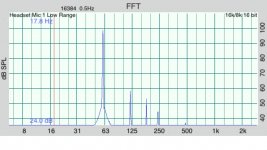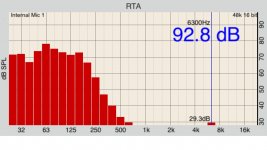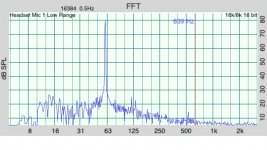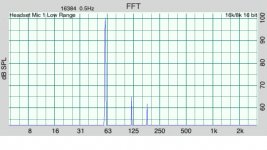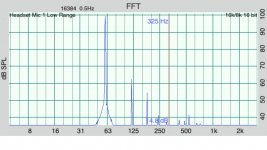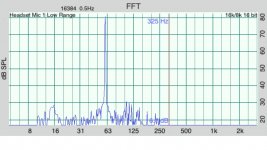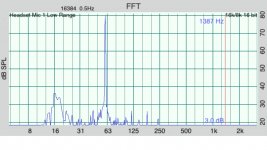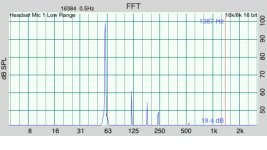Thanks for your input bansuri. I guess the limitation of my testing is my measurement setup. I only have a smartphone and a calibrated microphone. I can include some information about group delay from modeling software but I don't have a way to measure it.
To answer your question sixto I'm looking at quantitative and subjective measurements.
I have inspiration from a website called Databass. However in their testing the distortion levels get pretty high and they seem to have a focus on 18 or 21" monster subs. I've chosen a more stringent distortion limit of 5% THD and so far 12" subs. I could post all the charts from 16hz to 63hz but since I am reading the harmonics off of those charts the work is already done. I don't have much knowledge of harmonics below the fundamental but IMD in my opinion is a underrated distortion measurement.
By looking at the distortion profile we can see if a driver has asymmetry mechanically or electrically. In general mechanical asymmetry such as a suspension that is more stiff in one directional will result in 2nd order distortion and electrical asymmetry such as a change in voice coil inductance over excursion will show up as 3rd order distortion.
For subwoofer frequencies I find the 3rd order distortion more disturbing. Playing the same song through a lower distortion sub the bass will sound deeper.
But as I'm testing I've found distortion to be just a small piece of the puzzle. The dual dayton reference 12s that my system had originally were low distortion but just didn't sound right to me. Percussive bass from a kick or kettle drum didn't have impact. I understand that alot of the harmonics of these drums are handled by the midrange but even switching off my bookshelf speakers and listening to the sub on it's own I couldn't hear the peak of the drum hit. Because the distortion is low from 20hz-40hz I think these would be great subs for the rumbles of home theater if you had some big mains and could do a 50 hz crossover.
Maybe I am just spoiled because in the other room I have a system that uses a seven foot folded bass horn design by BFM. The bass horn does great with bass drums and helicopters flying overhead but the delicate notes on the lowest string of the upright bass seem overemphasized and there is sometimes little separation in the notes. A dipole system with heavy EQ I recently had setup could do the upright bass well but lacked impact in percussive bass. I think what I'm listening for when I compare driver is good attack and decay in the 50hz-100hz range.
So my quest is one sub that could do both drums and the upright bass...
To answer your question sixto I'm looking at quantitative and subjective measurements.
I have inspiration from a website called Databass. However in their testing the distortion levels get pretty high and they seem to have a focus on 18 or 21" monster subs. I've chosen a more stringent distortion limit of 5% THD and so far 12" subs. I could post all the charts from 16hz to 63hz but since I am reading the harmonics off of those charts the work is already done. I don't have much knowledge of harmonics below the fundamental but IMD in my opinion is a underrated distortion measurement.
By looking at the distortion profile we can see if a driver has asymmetry mechanically or electrically. In general mechanical asymmetry such as a suspension that is more stiff in one directional will result in 2nd order distortion and electrical asymmetry such as a change in voice coil inductance over excursion will show up as 3rd order distortion.
For subwoofer frequencies I find the 3rd order distortion more disturbing. Playing the same song through a lower distortion sub the bass will sound deeper.
But as I'm testing I've found distortion to be just a small piece of the puzzle. The dual dayton reference 12s that my system had originally were low distortion but just didn't sound right to me. Percussive bass from a kick or kettle drum didn't have impact. I understand that alot of the harmonics of these drums are handled by the midrange but even switching off my bookshelf speakers and listening to the sub on it's own I couldn't hear the peak of the drum hit. Because the distortion is low from 20hz-40hz I think these would be great subs for the rumbles of home theater if you had some big mains and could do a 50 hz crossover.
Maybe I am just spoiled because in the other room I have a system that uses a seven foot folded bass horn design by BFM. The bass horn does great with bass drums and helicopters flying overhead but the delicate notes on the lowest string of the upright bass seem overemphasized and there is sometimes little separation in the notes. A dipole system with heavy EQ I recently had setup could do the upright bass well but lacked impact in percussive bass. I think what I'm listening for when I compare driver is good attack and decay in the 50hz-100hz range.
So my quest is one sub that could do both drums and the upright bass...
Last edited:
Shrub, thx for the clarification of your set-up.
What you measure is a mixture of your room response and the driver.
There are big deviations of more than 20dB between your frequency points caused by room resonances. These are high Q, just a few Hz wide, only at higher frequencies above 400Hz they get close to each other, more continuous.
If there is a room resonance at the 2nd or 3rd harmonic it will show up boosted by say 10-15dB or dipped in an antiresonance.
The drivers have different fc and Qtc and also the distortion is not evenly rising to the low end, but also has peaks and dips. So your measurements will not be very valid.
If you have the possibility measuring outside >10m away from reflecting walls, the validity is almost perfect.
Then the drivers have a different treble response, which will influence your judgement about the sound, Some sound "metallic", some dull.
Always use a LR4 at 100Hz, this will allow you to hear the fundamental more clearly.
The bookshelf speaker should have a 2nd order Butterworth HP, which combines with the low end to a LR4.
What you measure is a mixture of your room response and the driver.
There are big deviations of more than 20dB between your frequency points caused by room resonances. These are high Q, just a few Hz wide, only at higher frequencies above 400Hz they get close to each other, more continuous.
If there is a room resonance at the 2nd or 3rd harmonic it will show up boosted by say 10-15dB or dipped in an antiresonance.
The drivers have different fc and Qtc and also the distortion is not evenly rising to the low end, but also has peaks and dips. So your measurements will not be very valid.
If you have the possibility measuring outside >10m away from reflecting walls, the validity is almost perfect.
Then the drivers have a different treble response, which will influence your judgement about the sound, Some sound "metallic", some dull.
Always use a LR4 at 100Hz, this will allow you to hear the fundamental more clearly.
The bookshelf speaker should have a 2nd order Butterworth HP, which combines with the low end to a LR4.
Thanks for your input Bansuri,
Yes, I understand that the ideal conditions are to measure outside but this is not an option available to me. Instead I measure in room and keep the speaker in the same position after switching drivers. I have a big null at 40 hz and a big peak at 60 hz. The null is seen in all my max output vs distortion data. I can use the parametric EQ on the subwoofer amp to bring the 60 hz peak down instead of chasing after the impossible in bringing up the null.
Yes, I understand that the ideal conditions are to measure outside but this is not an option available to me. Instead I measure in room and keep the speaker in the same position after switching drivers. I have a big null at 40 hz and a big peak at 60 hz. The null is seen in all my max output vs distortion data. I can use the parametric EQ on the subwoofer amp to bring the 60 hz peak down instead of chasing after the impossible in bringing up the null.
this is a great thread. and while i can measure and provide info often in the past i stick to real TS parameters, simmed info and the real electricial impedance of unstuffed to get help or ask questions because it always gets derailed by honest help that convinces me something is technically wrong and they are right. but not about my ears, only the "textbook' ears..
but you might relate to this??
i use a very rediculous by many standards, compound tapped pipe (sorta) tuned to 38-39hz. and an ISOBARIC rear vented mass loaded TL (sorta) tuned to 23-24hz. its because otherwise something else in the past was fun but not always sounded 'right'. i dont like "perfect" so i cant show it to anyone unless i lie. i have mtms with 4'' drivers above all this... so theres that too...
i said 'sorta" because whats in a name? confusion depending on whos talking and whos listening. but i can clearly show certain people one or the other, but not both, lol. martin king likes the MLTL but the other one he doest offer an opinion on... i understand and respect such thing...
this thread is great, im learning with you, have similar issues problably in bass speaker quest for excellent and the people are helping who commented i think i might like distortion and group delay way down low where it must exist anyhow, or i have grown acustom to the thought or sound of the thought... illl figure that out whe im asleep lol
i think i might like distortion and group delay way down low where it must exist anyhow, or i have grown acustom to the thought or sound of the thought... illl figure that out whe im asleep lol
but you might relate to this??
i use a very rediculous by many standards, compound tapped pipe (sorta) tuned to 38-39hz. and an ISOBARIC rear vented mass loaded TL (sorta) tuned to 23-24hz. its because otherwise something else in the past was fun but not always sounded 'right'. i dont like "perfect" so i cant show it to anyone unless i lie. i have mtms with 4'' drivers above all this... so theres that too...
i said 'sorta" because whats in a name? confusion depending on whos talking and whos listening. but i can clearly show certain people one or the other, but not both, lol. martin king likes the MLTL but the other one he doest offer an opinion on... i understand and respect such thing...
this thread is great, im learning with you, have similar issues problably in bass speaker quest for excellent and the people are helping who commented
 i think i might like distortion and group delay way down low where it must exist anyhow, or i have grown acustom to the thought or sound of the thought... illl figure that out whe im asleep lol
i think i might like distortion and group delay way down low where it must exist anyhow, or i have grown acustom to the thought or sound of the thought... illl figure that out whe im asleep lol
Last edited:
My next experiment was to run the ultimax 12 with only one of it's two coils.
As many know this will double the QES.
Here are my max spl before 5% distortion measurements.
Frequency Spl of fundamental 2nd harmonic 3rd harmonic
16 67 -41 -24
20 66 -29 -22
25 66 -23 -24
31.5 63 -23 -31
40 86 -23 -39
50 105 -29 -39
63 107 -37 -47
attached is 60hz@80db and 100db
As many know this will double the QES.
Here are my max spl before 5% distortion measurements.
Frequency Spl of fundamental 2nd harmonic 3rd harmonic
16 67 -41 -24
20 66 -29 -22
25 66 -23 -24
31.5 63 -23 -31
40 86 -23 -39
50 105 -29 -39
63 107 -37 -47
attached is 60hz@80db and 100db
Attachments
Next up is the DIYSG magnum 12" woofer found here:
https://www.diysoundgroup.com/magnum-12.html
This driver is really fun, it has been optimized for midbass kick and It gives a noticeable tactile feel to drums in music. I first tried it in a sealed configuration which is unflattering for such a high bl driver.
Here are my max spl before 5% distortion measurements.
Frequency Spl of fundamental 2nd harmonic 3rd harmonic
16 71 -40 -24
20 69 -34 -25
25 70 -30 -24
31.5 69 -24 -30
40 93 -27 -24
50 101 -35 -26
60 109 -30 -34
attached is 60hz @80db and 100db
https://www.diysoundgroup.com/magnum-12.html
This driver is really fun, it has been optimized for midbass kick and It gives a noticeable tactile feel to drums in music. I first tried it in a sealed configuration which is unflattering for such a high bl driver.
Here are my max spl before 5% distortion measurements.
Frequency Spl of fundamental 2nd harmonic 3rd harmonic
16 71 -40 -24
20 69 -34 -25
25 70 -30 -24
31.5 69 -24 -30
40 93 -27 -24
50 101 -35 -26
60 109 -30 -34
attached is 60hz @80db and 100db
Attachments
my next test was to add a 300uF series capacitor to the magnum in the sealed box. Hornresp predicts this will bump up the output 6db at 41hz however the group delay peaks at 25ms at 38hz vs staying under 5ms from 20hz up for the standard sealed box.
I found this increase in group delay to be audible in the song "temple caves" by Mickey Hart. In this song there is a massive drum with a 35hz fundamental. In my horn loaded speakers I can hear the drum getting louder and then decaying with each hit. With the magnum and capacitor I getting an almost sustained tone.
Could also be the inertia and stored energy of a single 12 trying to do 35hz.
Here are my max spl before 5% distortion measurements.
Frequency Spl of fundamental 2nd harmonic 3rd harmonic
16 64 -45 -26
20 66 -33 -27
25 69 -28 -25
31.5 67 -23 -32
40 86 -25 -35
50 101 -35 -25
63 111 -25 -29
attached is 60hz @80db and 100db and the predicted group delay
I found this increase in group delay to be audible in the song "temple caves" by Mickey Hart. In this song there is a massive drum with a 35hz fundamental. In my horn loaded speakers I can hear the drum getting louder and then decaying with each hit. With the magnum and capacitor I getting an almost sustained tone.
Could also be the inertia and stored energy of a single 12 trying to do 35hz.
Here are my max spl before 5% distortion measurements.
Frequency Spl of fundamental 2nd harmonic 3rd harmonic
16 64 -45 -26
20 66 -33 -27
25 69 -28 -25
31.5 67 -23 -32
40 86 -25 -35
50 101 -35 -25
63 111 -25 -29
attached is 60hz @80db and 100db and the predicted group delay
Attachments
Last edited:
Another test and so far one of my favorites. I added the scanspeak passive radiator to the magnum 12 and removed the capacitor. So 60 liters with a 20hz passive radiator tuning. This is similar to a flex 12 subwoofer design you can find on AVSforum.
I really like this setup there is tactile feel to the bass. Listening to Fleetwood Mac the bass guitar and bass drum were two separate instruments not blobbed together as one as I hear them in many woofers. Finesse with an upright bass is near what it was with the radioshack 12 however the magnum is more clean in the deep bass. Also temple caves is more realistic with this setup I'm hearing the giant drum hits clearly.
I started a thread on Hifi circuit were some of the designers of DIYSG speakers lurk, maybe they can help me understand the magic behind what I'm hearing:
Why does the magnum 12 sound so good? | HiFiCircuit
Frequency Spl of fundamental 2nd harmonic 3rd harmonic
16 74 -23 -24
20 86 -32 -26
25 84 -28 -24
31.5 67 -20 -32
40 95 -25 -24
50 100 -35 -26
63 110 -25 -32
attached is 60hz @80db and 100db
I really like this setup there is tactile feel to the bass. Listening to Fleetwood Mac the bass guitar and bass drum were two separate instruments not blobbed together as one as I hear them in many woofers. Finesse with an upright bass is near what it was with the radioshack 12 however the magnum is more clean in the deep bass. Also temple caves is more realistic with this setup I'm hearing the giant drum hits clearly.
I started a thread on Hifi circuit were some of the designers of DIYSG speakers lurk, maybe they can help me understand the magic behind what I'm hearing:
Why does the magnum 12 sound so good? | HiFiCircuit
Frequency Spl of fundamental 2nd harmonic 3rd harmonic
16 74 -23 -24
20 86 -32 -26
25 84 -28 -24
31.5 67 -20 -32
40 95 -25 -24
50 100 -35 -26
63 110 -25 -32
attached is 60hz @80db and 100db
Attachments
I dont know about the evidence, but I agree that it seems we are less sensitive to even order thd, even in the midrange, as we often tend to describe it as "warmness", "richness" or "fullness" as the harmonics agrees with tonal character to a greater extent then odd order harmonics, wich has a very different character to our ears.I think there's a lot of evidence that people prefer subs with moderate amounts of distortion.
Then there is the familiarity aspect, if you are used to a greater amount of favourable character distortion one might react to it being taken away, and expirience the sound as "cold" or "thin".
It depend a lot of kind of music. In a lot of modern music, there's already distortion in the content, tuned depending on desired effect. Adding over again another layer of distortion on all the content without distinction is like adding a color filter on a picture. Sure, it can be nice.
With good recording, it's really not something you want. Mastering have already tuned all, and sometime even already added if desired, a layer of low end distortion (MaxxBass effect for example).
With good recording, it's really not something you want. Mastering have already tuned all, and sometime even already added if desired, a layer of low end distortion (MaxxBass effect for example).
i wish i was better with adjectives or subjective descriptions of sound, but Martisonn's are not the first time ive heard exactly what he stated. and in regards to the same type of cabinet. ive built 3 now and the most recent one is very skewed toward the ROAR layout then previous. i dont know if ill retain the signature bass sound/feel of hybrid tapped pipes...
my aim is to create an 'acoustic amplifier' as the section downstream the tapped motorside entry. and essentially use the section prior to it as the equivalent to an end fired constant CSA TL(pipe)with at its terminus before the >boosted< segment.. mixing in a prouder knee on a previously damped pipe is kinda tricky, following the wave form bulge in one two segments entry is pretty far from ideal. espsecially if its already has matured as a qw Fb.
my aim is to create an 'acoustic amplifier' as the section downstream the tapped motorside entry. and essentially use the section prior to it as the equivalent to an end fired constant CSA TL(pipe)with at its terminus before the >boosted< segment.. mixing in a prouder knee on a previously damped pipe is kinda tricky, following the wave form bulge in one two segments entry is pretty far from ideal. espsecially if its already has matured as a qw Fb.
I am missing some basic process for integrating subwoofers here. A well built subwoofer does not “separate” bass notes or provide slam. That happens above 100 Hz.
I would suggest taking one subwoofer. Put it in a corner and measure (no smoothing)4 or 5 various positions in the room - but at listening height. Compare the frequency responses and you will see how much the room has to say: +- 20dB for sure - regardless of cost!
Now put you measurement mic at your normal listening position and move the subwoofer. Comparing the measurements will confirm that manipulating the room is 99% of success.
⅓ octave smoothing simply gives you a nice looking but worthless measurement. Smaller woofers with higher levels of distortion play back frequencies outside of the subwoofer range.
I firmly believe that the requirements from 100 to 200 Hz are much different than from 50 to 100 Hz and yet more different from 25 to 50 Hz. Anyone interested in infrasonics(<25Hz) needs to invest much more in experience as in normal living rooms we are partially pressurizing the room - much different than those frequencies in a large church or concert hall.
I would suggest taking one subwoofer. Put it in a corner and measure (no smoothing)4 or 5 various positions in the room - but at listening height. Compare the frequency responses and you will see how much the room has to say: +- 20dB for sure - regardless of cost!
Now put you measurement mic at your normal listening position and move the subwoofer. Comparing the measurements will confirm that manipulating the room is 99% of success.
⅓ octave smoothing simply gives you a nice looking but worthless measurement. Smaller woofers with higher levels of distortion play back frequencies outside of the subwoofer range.
I firmly believe that the requirements from 100 to 200 Hz are much different than from 50 to 100 Hz and yet more different from 25 to 50 Hz. Anyone interested in infrasonics(<25Hz) needs to invest much more in experience as in normal living rooms we are partially pressurizing the room - much different than those frequencies in a large church or concert hall.
My experience is that there is a lot of "music" and definition below 100Hz, a subwoofer's ability to render details and provide definition all the way down to its lower limit is to me a bit of a quality marker, and it makes a lot of difference for the whole spectrum of the music in my opinion, like it all stands on a firm and defined base instead of floating around on a undefined muddy mess of low frequency rumble that every once in a while manages to provide the correct note at the correct time.A well built subwoofer does not “separate” bass notes or provide slam. That happens above 100 Hz.
I'm not addressing this to any particular brand or model, but I can confidently say that in my experience this is more common in small speakers and small subwoofers trying to hit above their weight, especially if they are pushed close to their limit, and this goes even expensive ones.
...But as I'm testing I've found distortion to be just a small piece of the puzzle. The dual dayton reference 12s that my system had originally were low distortion but just didn't sound right to me. Percussive bass from a kick or kettle drum didn't have impact. I understand that alot of the harmonics of these drums are handled by the midrange but even switching off my bookshelf speakers and listening to the sub on it's own I couldn't hear the peak of the drum hit. Because the distortion is low from 20hz-40hz I think these would be great subs for the rumbles of home theater if you had some big mains and could do a 50 hz crossover.
Maybe I am just spoiled because in the other room I have a system that uses a seven foot folded bass horn design by BFM. The bass horn does great with bass drums and helicopters flying overhead but the delicate notes on the lowest string of the upright bass seem overemphasized and there is sometimes little separation in the notes. A dipole system with heavy EQ I recently had setup could do the upright bass well but lacked impact in percussive bass. I think what I'm listening for when I compare driver is good attack and decay in the 50hz-100hz range.
So my quest is one sub that could do both drums and the upright bass...
I commend you on sharing the results of your research. I am looking for similar qualities, though I don't need the ultra-low frequency rumble I associate with movies, (I'm ok if SPL drops below 25hz)i am looking for the visceral impact of a kick drum, or gun-shot. I believe to accurately reproduce these sounds, I need to allow some higher-frequency harmonics, so I've been looking at amps with higher Damping factor (>50), low-Q drivers in relatively small sealed enclosures as a way to achieve my goals (system Q of about .6). Your investigation of Harmonics is intriguing, but if as you say, harmonics are only part of the solution-maybe broadening the search to other parameters might help you find that happy medium. (Or perhaps they are mutually exclusive goals?). Thanks, Six
Thanks for everyone's input. I've been building speakers for 22 years and since it's a hobby and have other responsibilites I design in simulation software and then months sometimes years later I am able to hear my results.
What's different about this "project" is that I have a solid enclosure with t-nuts and a passive radiator and with the help of some used sub purchases, I can change a driver and go from sealed to passive radiator in a matter of minutes. Playing the same song 5 minutes later I can hear a difference in subs.
Yes the sound of a subwoofer is dictated by the room, but keeping the room constant and the variable the sub I can hear large differences in the sound quality of different subs.
I have spent many hours scouring forums reading about the importance of low flux modulation, how moving mass doesn't matter, how some say a low RMS suspension value is important. How group delay in the lowest frequency doesn't matter etc... I also enjoyed an article on DIYMA on how a horn subwoofer sounds tight because although there is a 90 degree phase lag and a delay in the horn path, the phase lag is fairly constant in the operating range and thus the fundamental of a kick drum at 50hz and it's harmonic at 100hz have similar phase and group delay and they sound pleasing to the ear (thanks Patrick Bateman). I think I hear this with my horn loaded subs.
All the information on forums is interesting but what I do trust is my ears I was a bass player in the orchestra in high school and college and enjoy music from sun up to sun down. What I can tell you is this, the dayton reference subs look great on paper but sound like mush to me. Manufactured supplied xmax really isn't that useful. I got way more output at low distortion with the reference sub with 14mm xmax that the ultimax with 19mm xmax.
What's different about this "project" is that I have a solid enclosure with t-nuts and a passive radiator and with the help of some used sub purchases, I can change a driver and go from sealed to passive radiator in a matter of minutes. Playing the same song 5 minutes later I can hear a difference in subs.
Yes the sound of a subwoofer is dictated by the room, but keeping the room constant and the variable the sub I can hear large differences in the sound quality of different subs.
I have spent many hours scouring forums reading about the importance of low flux modulation, how moving mass doesn't matter, how some say a low RMS suspension value is important. How group delay in the lowest frequency doesn't matter etc... I also enjoyed an article on DIYMA on how a horn subwoofer sounds tight because although there is a 90 degree phase lag and a delay in the horn path, the phase lag is fairly constant in the operating range and thus the fundamental of a kick drum at 50hz and it's harmonic at 100hz have similar phase and group delay and they sound pleasing to the ear (thanks Patrick Bateman). I think I hear this with my horn loaded subs.
All the information on forums is interesting but what I do trust is my ears I was a bass player in the orchestra in high school and college and enjoy music from sun up to sun down. What I can tell you is this, the dayton reference subs look great on paper but sound like mush to me. Manufactured supplied xmax really isn't that useful. I got way more output at low distortion with the reference sub with 14mm xmax that the ultimax with 19mm xmax.
Last edited:
- Home
- Loudspeakers
- Subwoofers
- A tale of 12" subwoofers, distortion and 15 dollars.
